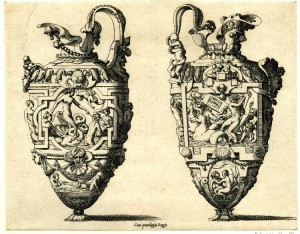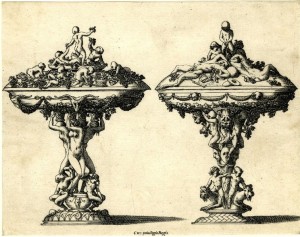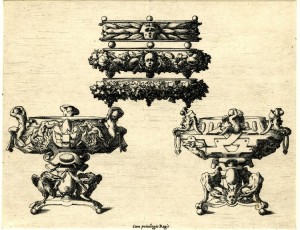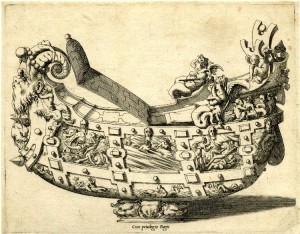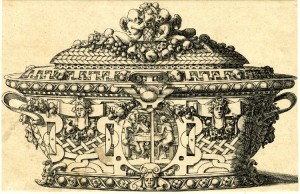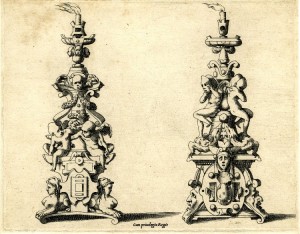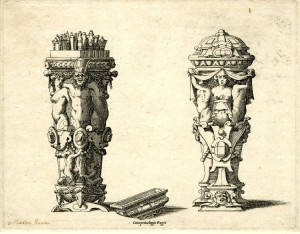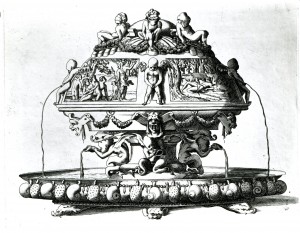Nine engravings by René Boyvin?, for measurements see impressions below. Inscribed (except the ninth, Robert-Dumesnil, 79, 179) in the middle at the bottom: Cum priuilegio Regis. The appearance of numbers on some of the impressions of these prints in New York would seem to indicate a second numbered state of this series.
Robert-Dumesnil, VIII, 1850, 76-79, 171-179, as Boyvin. Le Blanc, 1854-1890, I, 507, 163-171. Destailleur, 1895, 95, no. 411, 2 (9 prints).
LITERATURE:
Kusenberg, 1931, 105, 157, 162, 203, ns. 259-261 (six mentioned but nine catalogued), Pl. LVIII, lower right (Paris), as Boyvin after Rosso.
Linzeler, 1932, 200-201, as Boyvin.
Collijn, 1933, 27, no. 31, with bibliography, and list of collections that have these prints.
Levron, 1941, 80, 287-295, as Boyvin although not signed and as after Rosso.
For individual prints see LITERATURE below.
|
RE.11, 1. (Robert-Dumesnil, 171). Two Pitchers, the One on the Left with a Sea Goddess in Her Chariot, the One on the Right With Neptune in His, 14 x 18.1 P (New York, 25.24.1). Fig.RE.11,1 (London) COLLECTIONS: Amsterdam (De Jong and de Groot, 1988, 285, 632.1, as Boyvin after Rosso). Berlin, Kunstbibliothek, OS 1040. London, 1887,1010.14.1. New York, 25.24.1, and 49.95.197 a and b (print cut in two). Paris, Ed 3, in-folio, and Supp.n.rel. Stockholm, 113. Vienna, F.I.3, p.36c, no. 130. Dr. Vadim Cotlenko Collection (see below). LITERATURE: Thirion, 1971, 45, Fig. 42 (Paris), 46-47, as Boyvin apparently after Rosso; identified the sea goddess as Venus (as do Robert-Dumesnil, Linzeler, and Levron), 46, no. 9, confused reference to Levron, 1941. K. Wilson-Chevalier, in Fontainebleau, 1985, 95-96, no. 43 (Cotlenko), as Boyvin after Thiry. De Jong and de Groot, 1988, 285, under 632.1, note that the pitcher is similar to that in another print by Boyvin, their 590.7.1 Fuhring, 1989, 333, states that there is a copy of this print in Brussels (Bibliothèque Royale Albert Ier, 5.11.9648) that bears “an old inscription in pen and ink: Rous, which would support the attribution of the design to Rosso.” |
|
RE.11, 2. (Robert-Dumesnil, 172). Two Covered Dishes on High Bases, the One on the Left with a Bacchanal of Putti on the Lid, the One on the Right with Two Sleeping Satyrs and a Peeing Putto, 14.2 x 18.1 S (Vienna). Fig.RE.11,2 (London) COLLECTIONS: Amsterdam (De Jong and de Groot, 1988, 285, 632.2, as Boyvin after Rosso). Berlin, Kunstbibliothek, OS 1040. London, 1887,1010.14.2. New York, 49.95.198 a and b (cut in two). Paris, Ed 3, in-folio, and Supp.n.rel. Stockholm, 111. Vienna, F.I.3, p.36c, no. 131. LITERATURE: Kusenberg, 1931, Pl. LVIII, upper left (Paris). RELATED DRAWING: Edinburgh, National Gallery of Scotland, D. 2566 (Fig.RE.11,2, Edinburgh). Pen, brown ink and wash, over traces of black chalk, 14.4 x 9.2. Andrews, 1968, I, 154, II, Fig. 1069. This drawing of two halves of two dishes separated by a margin shows the left half of the right engraved dish and the right half of the left one, in the same direction as the print. However, a number of small details, such as the bald head of the seated figure at the lower left, indicate that the drawing was not copied from the print. It is very likely that the drawing was copied from two drawings that served as the model for the print. Graphically the drawing resembles that of the Design for a Covered Cup inscribed: Leonard Thierry, in the Victoria and Albert Museum (Fig.RD.22). Andrews commented that the drawing resembles the table pieces attributed to Rosso and Thiry. Given its resemblance to the drawing in London, it would seem to be a copy of a drawing by Thiry. It should be noted that while the two dishes are exactly the same height in the engraving, in the drawing the left one – the right in the print – is larger because at the bottom the seated figure and the animal are considerably bigger. The change in the sizes of the dishes was probably made because the engraver wished to put them together in one print. Such alterations as appear in the print could have been made by someone in the engraver’s shop when preparing from the original drawings the model from which the engraving was actually made. At the right of the drawing is the blurred depiction in chalk of a papal tiara. On the verso is a drawing of a reclining River God (Fig.RE.11,2, Edinburgh verso) with a papal tiara and a lion’s head at its feet, set over an arch, the underside of which is ornamented. |
|
RE.11, 3. (Robert-Dumesnil, 173). Two Saltcellars on High Bases, the One on the Left with a Many-Breasted Cybele Reclining On Top, the One on the Right with a Reclining Neptune, 14.2 x 18.2 P (New York, 25.24.4). Fig.RE.11,3 (New York, 49.95.199 a and b) COLLECTIONS: Amsterdam (De Jong and de Groot, 1988, 285, 632.3, Fig., as Boyvin after Rosso). Berlin, Kunstbibliothek, OS 1040. London, 1885,0612.30, bottom. New York, 25.24.4 (in the upper right corner inscribed: 3), and 49.95.199 a and b (cut in two). Paris, Ed 3, in-folio, and Supp.n.rel. (two impressions). Stockholm, 109. Vienna, F.I.3, p.36c, no. 132. LITERATURE: Jessen, 1920, 73, Fig. 52 (left saltcellar), as Boyvin. Kusenberg, 1931, Pl. LVIII, upper right (Paris). Thirion, 1971, 46, Fig. 43 (Paris), 46, n. 91 (confused reference to Levron), 47, as Boyvin after Rosso. K. Wilson-Chevalier, in Fontainebleau, 1985, 130-131, no. 75 (Paris, Ed 3), as perhaps by Boyvin and certainly after Thiry. |
|
RE.11, 4. (Robert-Dumesnil, 174). Five Dishes, Two With High Bases, 14.1 x 18.1 P (New York, 25.24.5). Fig.RE.11,4 (London) COLLECTIONS: Amsterdam (De Jong and de Groot, 1988, 285-286, 632.4, Fig., as Boyvin after Rosso). Berlin, Kunstbibliothek, OS 1040. London, 1888,1010.14.4. New York, 25.24.5 (in the upper right corner inscribed: 4), and 49.95.20 a, b and c (cut in three pieces). Paris, Ed 3, in-folio, Le. 50.a.Rés., in-80, and Supp.n.rel. Stockholm, 110. Vienna, F.I.3, p.36c, no. 133. LITERATURE: Kusenberg, 1931, Pl. LVIII, 3, lower left (Paris). |
|
RE.11, 5. (Robert-Dumesnil, 175). Large Boat-Like Container with a Lid Open Showing Folded Cloth Inside, 14 x 18.2 P (New York, 25.24.6). Fig.RE.11,5 (London) COLLECTIONS: Amsterdam (De Jong and de Groot, 1988, 286, 632.5, Fig., as Boyvin after Rosso). London, 1887,1010.14.5. London, Victoria and Albert Museum, E.1027-1908. New York, 49.95.201 (inscribed in ink above center: acrvra) and 25.24.6. Paris, Ed 3, in-folio, and Le.50.a.Rés., in-80. Vienna, F.I.3, p.136c, no. 134. LITERATURE: Hayward, 1963, I, 240, Fig. 1, 242-243, as Boyvin after Rosso. Ward-Jackson, 1967, Fig. 11, as Boyvin perhaps after Rosso. Zerner, in EdF, 1972, 332-333, no. 438, ill. p.334 (Paris, Ed 3), as Anonymous, perhaps by Milan, suggesting as after Thiry, and questioned Levron’s identification of it as a “nef for napkins.” Pope-Hennessy, 1985, 113, Fig. 38 (Paris), as Boyvin or Milan, probably after Rosso. Acton, in French Renaissance, 1994, 315-317, no. 80, Fig. (Paris, Ed 3, vol. 2), as Boyvin or Milan, after Rosso or Thiry. RELATED DRAWING: Bérard Collection, no. 51 of 1891 catalogue. Pen and ink, 13 x 26. This drawing is mentioned by Levron, 1941, 62, no. 28, as a preliminary drawing for this print. The Bérard Collection was dispersed in 1891 (Levron, 1941, 61) and the present whereabouts of this drawing are unknown. Robert-Dumesnil (VIII, 1850, 78, n. 1) identified this object as a nef to hold the napkins of the King and Queen. This was questioned by Zerner. But the object does show some folded linen within it. Pope-Hennessy recognized it as a nef. Acton said it is certainly a nef, for ceremonial purpose and for persons of high rank, in which one placed napkins, knife and fork to protect from poison, hence the form of a ship untouched by storms. |
|
RE.11, 6. (Robert-Dumesnil, 176). A Broad Tureen with Handles and a Lid with a Relief of Jupiter and Mercury in the House of Philemon and Baucis on the Front, 14.4 x 18.5 S (New York, 49.95.202). Fig.RE.11,6 (London) COLLECTIONS: Amsterdam (De Jong and de Groot, 1988, 286, 632.6, Fig., as Boyvin after Rosso). Hamburg. London, 1887,1010.14.6. New York, 49.95.202 (inscribed in ink above center: Arcula / cofra da pann) and 25.24.7. Paris, Ed 3, in-folio, and Le.50.a.Rés., in-80. Vienna, F.I.3, p.36d, upper left. LITERATURE: Döry, 1960, 63, no. 345. Farmer, John Davis, The Virtuoso Craftsman: Northern European Design in the Sixteenth Century, exh. cat., Worcester Art Museum, 1969, 62-65, no. 22, 64, Fig., as Boyvin after Rosso. Zerner, in EdF, 1972, 335, no. 442, as Anonymous, perhaps by Milan, suggesting as after Thiry. Fuhring, in French Renaissance, 1994, 317, no. 81, Fig. (Paris, Ed 3, vol. 2), as Boyvin or Milan after Rosso or Thiry. |
|
RE.11, 7. (Robert-Dumesnil, 177). Two Candlesticks, 14.1 x 18.1 P (New York, 25.24.8). Fig.RE.11,7 (London) COLLECTIONS: Amsterdam (De Jong and de Groot, 1988, 286, 632.7, as Boyvin after Rosso). Berlin, Kunstbibliothek, OS 1040. London, 1887,1010.14.7. New York, 25.24.8, and 49.95.203 a and b (cut in two). Paris, Ed 3, in-folio. Stockholm, 148. Vienna, F.I.3, p.36d, upper right. |
|
RE.11, 8. (Robert-Dumesnil, 178). Two Tall Knife Containers with Lids, One Lid Lying at the Side of the Left Container, 14.1 x 18.1 (New York, 25.24.9). Fig.RE.11,8 (London) COLLECTIONS: Amsterdam (De Jong and de Groot, 1988, 286, 632.8, as Boyvin after Rosso). Berlin, Kunstbibliothek, OS 1040. Hamburg. London, 1887,1010.14.8. New York, 25.24.9, and 49.95.204 a and b (cut in two; the first inscribed above in ink: Thvca cultrorum / Arcula cultrarum, the last two words cancelled, the second half inscribed: Thvca cultrorum). Paris, Ed 3, in-folio, Le.50.a Rés., in-80, and Supp.n.rel. Stockholm, 112. Vienna, F.I.3, p.36d, lower left, and H.B.IV, p.78. LITERATURE: Döry, 1960, 63, no. 345. Thirion, 1971, 47, mentioned as “deux nécessaires du table,” as apparently after Rosso. |
|
RE.11, 9. (Robert-Dumesnil, 179). A Table Fountain with Two Scenes in Relief from the Story of Diana and Acteon, 14.1 x 18.3 (Vienna, F.I.3, p.36d). Fig.RE.11,9 (Vienna) COLLECTIONS: Berlin, Kunstbibliothek, OS 1040. London, 1887,1010.14.9. Paris, Ed 3, in-folio. Vienna, F.I.3, p.36d, lower right. Dr. Vadim Cotlenko Collection (see below). LITERATURE: Thirion, 1971, 46, Fig. 44, 47, as Boyvin, implying as after Rosso. K. Wilson-Chevalier, in Fontainebleau, 1985, 95-96, no. 44 (Cotlenko), as Boyvin after Thiry. Acton, in French Renaissance, 1994, 319-320, no. 82, Fig. (Paris, Ed 3, vol. 2), as Boyvin or Milan after Rosso or Thiry. |
These nine prints, representing eighteen objects for table use, are all of the same size and manner of engraving and hence would seem to form a set, and as such they have been catalogued several times. Stylistically they are also very similar, and sufficiently so in so many details that it is most likely that all were designed by the same artist. Kusenberg’s suggestion that that artist was Rosso was accepted by Levron and Hayward and thought to be possible by Thirion. However, this attribution has not always been recognized. Robert-Dumesnil made no mention of Rosso, nor of any other designer. Jessen, in 1920 (71), attributed them to Thiry, and Lieure, in 1928 (131), suggested Cellini. Barocchi, in 1950 (252), thought that except for an unspecified few their designs were closer to Cellini than to Rosso. Zerner, in 1972, again brought up the name of Thiry, indicating that Oberhuber, 1967-1968 (169), also made this suggestion, although the latter’s comment on Thiry’s decorative style is not made specifically about these prints. But Raggio, in 1974 (74), thought they reflected projects by Rosso.
In 1568, Vasari (II, 211; Vasari-Milanesi, V, 170) reported that Rosso made such designs of objects for the table, which Francis I then had executed in silver; Vasari also stated (1568, II, 308; Vasari-Milanesi, V, 433-434) that Boyvin engraved them. However, none of the engravings bears Rosso’s name, nor Boyvin’s name or monogram, for that matter. Vasari may have heard that Rosso had made such designs and the prints, which for some reason he believed were related to Boyvin, would, in the style of the objects they represent, have affirmed for him they were designed by Rosso. But Vasari would not have been able to know if these designs were merely Rossoesque rather than actually by Rosso himself, as he probably would not have been in a position to know if the prints were actually by Boyvin himself. He thought the engravings were done after Rosso’s death.
There would seem to be no reason not to believe the report that Vasari probably had heard that Rosso made designs for table objects. No document specifically mentions him in this regard but one of 15 September 1537 (Laborde, 11, 1880, 234) records a payment to the goldsmith, Thibault Hotman, for the making of a “vaisselle d’argent” as a gift of Francis I to the King of Scotland, James V, who married Francis I’s daughter, Madeleine, in Paris on 1 January 1537. This object, very likely a wedding gift, may have been made late in 1536, although it could also have been made after the wedding, and it could have been designed by Rosso. That Rosso designed objects for Francis I’s own table, as Vasari indicated – see L.51 – is suggested by a drawing inscribed with Rosso’s name in St. Petersburg (Fig.D.49), which seems to be a copy of a lost design by Rosso for a candlestick. It is decorated with salamanders, one of the King’s devices (Kusenberg, 1931, 203, n. 259, stated that Florent Le Comte, in his Cabinet des Singularitez, III, Brussels, 1702, 9-11, mentioned that the table service designed by Rosso was used at the banquet given by Francis I on the occasion of Charles V’s visit to Fontainebleau late in 1539, but whether or not this is a piece of information derived from a contemporary source is not known.) Of the eighteen objects of the engravings catalogued here, two – the two dishes with high bases (Fig.RE.11,4) – are also decorated with salamanders. But they need not specifically reproduce designs by Rosso; they may only reflect the kinds of designs he made.
Of all these engraved designs, only the two dishes with high bases come close to what might be expected of Rosso, as seems presented by the candlestick design in St. Petersburg, the draughtsmanship of which seems also to reflect his. But certain details of the dish with a high base at the right – the masks with their corrugated extended chins and the reliefs of cupid with bow and arrow and of a cupid embracing a figure – do not seem to indicate Rosso’s decorative vocabulary as we know it from the Gallery of Francis I and from such a work as the Petrarch drawing at Christ Church (Fig.D.47a). There is a mock pathos about the putti of the other dish that is not characteristic of his art. All the other designs of the other eight engravings are even further removed from Rosso’s style in their high elaboration, in their naturalistic detail, and in their anecdotal individual figures and figured scenes. In spite of the obvious relation of the decorative language of these objects to Rosso’s, their style is much more specifically related to what appears in Thiry’s Story of Jason designs, engraved by Boyvin (RE.15). So close are they, in fact, that it can be suggested with some confidence that these engraved designs are based on drawings by that Flemish follower of Rosso, as proposed also by Kathleen Wilson-Chevalier (see first LITERATURE above). He seems also to be the author of the two dishes with high bases and the other three dishes that accompany them for the same reason and because of a certain doleful quality of their figures that is quite unlike Rosso’s mordant expressiveness.
That the designs of these objects very probably reflect the kind that Rosso invented cannot be altogether ignored but in these prints whatever is derived from Rosso has been reformulated by a quite different imagination. However, it must also be recognized that even Thiry’s designs may not be absolutely faithfully reproduced in these engravings. The evidence of the Edinburgh drawing related to the Two Covered Dishes on High Bases indicates that even his drawings, if they were used as models, could sometimes, at least, be modified because of the exigencies of turning them into prints.
Because they bear neither Boyvin’s name nor monogram Levron catalogued these engravings as products of his shop. Zerner preferred to recognize them as by an anonymous engraver but suggested that they could be by Milan because he is known to have made prints of such objects. Metman (1941, 206) did list some such prints engraved by Milan before 25 October 1549: “Vingt-quatre vases en 4 planches” and “deux flacons.” But these references cannot be specifically related to any known prints. As it is very likely that it is the nine prints catalogued here, or some of them, that Vasari knew or had heard of as by Boyvin, it is reasonable, until certain evidence to the contrary is forthcoming, to continue to associate them with that engraver.
1 Robert-Dumesnil, VIII, 1850, 70, 142 (Fig.Pitcher with Apollo), Paris, Hd 101, in-folio, p.43, no. 8.

